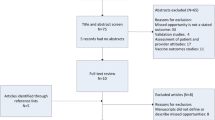Abstract
Objective
To evaluate the effectiveness of pediatric practice consultation in reducing missed-opportunity rates at eight pediatric sites in Baltimore, Maryland. The overarching goal was to decrease the occurrence of missed opportunities from 33% to 15% for the first, second, and third diphtheria and tetanus toxoids and pertussis vaccines during visits at which children were eligible for the vaccines.
Design
The effect of an in-office educational program alone at four sites is compared with the educational program and a consultation on office vaccination practices at four matched sites. All eight sites received a small grant ($2,000) to fund practice changes. The medical records of children making visits before and after the interventions were audited to determine missed-opportunity rates. The policies and operations and the knowledge, attitudes, and practices of physicians and nurse practitioners at each site were also assessed.
Results
The four education-consultation sites experienced a statistically significant 14% net reduction in the missed-opportunity rate relative to the education-only sites. This positive effect, however, was largely due to an increase in missed opportunities at one education-only site. There was a 10% increase in the missed-opportunity rate among the education-only sites and a 4% decrease among the education-consultation sites; neither change was statistically significant. Two of the three sites that reduced missed opportunities were matched health maintenance organizations (HMOs). Shortly after the interventions, both HMOs implemented tracking and follow-up information systems, which were planned before the interventions.
Conclusions
There is no evidence that either the educational program alone or the educational program and consultation combination reduced missed opportunities. The findings suggest that improved tracking and follow-up data systems and vaccination of children at sick visits may reduce missed opportunities.
Similar content being viewed by others
References
Centers for Disease Control and Prevention. Reported vaccine-preventable disease—United States, 1993 and the Childhood Immunization Initiative.MMWR Morb Mortal Wkly Rep. 1994;43(4):57–60.
Guyer B, Hughart N, Holt E, et al. Immunization coverage and its relationship to preventive health care visits among inner-city children in Baltimore.Pediatrics. 1994; 94(1):53–58.
Centers for Disease Control and Prevention. Retrospective assessment of vaccination coverage among school-aged children-selected US cities, 1991.MMWR Morb Mortal Wkly Rep. 1992;41:103–107.
Holt E, Guyer B, Hughart N, et al. The contribution of missed opportunities to childhood underimmunization in Baltimore.Pediatrics 1996;97(4):474–80.
Szilagyi PG, Rodewald LE, Humiston SG. Missed opportunities for childhood vaccinations in office practices and the effect on vaccination status.Pediatrics. 1993;91:1–7.
Centers for Disease Control and Prevention. Impact of missed opportunities to vaccinate preschool-aged children on vaccination coverage levels-selected US sites.MMWR Morb Mortal Wkly Rep. 1994;43:709–718.
Szilagyi PG, Rodewald LE. Missed opportunities for immunizations: a review of the evidence.J Public Health Manage Prac. 1996;2(1):18–25.
Bell LM, Lopez NI, Pinto-Martin J, Casey R, Gill FM. Potential impact of linking an emergency department and hospital-affiliated clinics to immunize preschool-age children.Pediatrics. 1994;93:99–103.
Farizo KM, Stehr-Green PA, Markowitz LE, Patriarca PA. Vaccination levels and missed opportunities for measles vaccination: a record audit in a public pediatric clinic.Pediatrics. 1992;89:589–592.
Hadler SC, Cutts F, Linkins R, et al. A study comparing selected immunization practices in two cities with differing immunization coverage of preschool children. In: Yerges C, ed.Proceedings of the 25th National Immunization Conference. Washington, DC: Centers for Disease Control and Prevention, 1991:105–109.
Gindler JS, Cutts FT, Barnett-Antinori ME, et al. Successes and failures in vaccine delivery: evaluation of the immunization delivery system in Puerto Rico.Pediatrics. 1993;91:315–320.
Kentucky Department for Health Services, Division of Epidemiology. Birth-certificatebased immunization survey.Kentucky Epidemiol Notes Rep. 1992;27:1–4.
McConnochie KM, Roghmann KJ. Immunization opportunities missed among urban poor children.Pediatrics. 1992;89:1019–1026.
Rodewald LE, Szilagyi PG, Humiston SG, et al. Is an emergency department visit a marker for undervaccination and missed opportunities among children who have access to primary care?Pediatrics. 1993;91:605–611.
Rodewald LE, Szilagyi PG, Humiston SG, Raubertas RF, Roghmann KJ, Hall CG. The effect of emergency department (ED) immunization on immunization rates and subsequent primary care utilization [abstract]. In: Lister G, ed.Abstracts of the American Pediatric Society and The Society for Pediatric Research. Abstract 870. Baltimore: Williams & Williams, 1994.
Szilagyi PG, Rodewald LE. Missed opportunities for influenza vaccination among children with asthma.Pediatr Infect Dis J. 1992;11:705–708.
Hughart N, Guyer B, Stanton B, et al. Do provider practices conform to the new pediatric immunization standards.Arch Pediatr Adolesc Med. 1994;148:930–935.
Advisory Committee on Immunization Practices. General recommendations on immunization, recommendations of the Advisory Committee on Immunization Practices (ACIP).MMWR Morb Mortal Wkly Rep. 1994;43(RR-1):1–38.
US Department of Health and Human Services, Public Health Service.Standards for Pediatric Immunization Practices. Atlanta, Ga: National Center for Prevention Services, Centers for Disease Control and Prevention; 1993.
Guyer B, Holt E, Hughart N, et al. The Baltimore Immunization Study phase II: effectiveness of pediatric practice consultation in missed opportunities [report to the Centers for Disease Control and Prevention]. September 1995.
Greco PJ, Eisenberg JM. Changing physicians’ practices.N Engl J Med. 1993;329:1271–1274.
Author information
Authors and Affiliations
Corresponding author
Additional information
This study was funded by the Centers for Disease Control and Prevention, contract number 200-90-0850.
Rights and permissions
About this article
Cite this article
Hughart, N., Holt, E., Rosenthal, J. et al. Effectiveness of pediatric practice consultation on missed opportunities for immunization. J Urban Health 75, 123–134 (1998). https://doi.org/10.1007/BF02344934
Issue Date:
DOI: https://doi.org/10.1007/BF02344934




